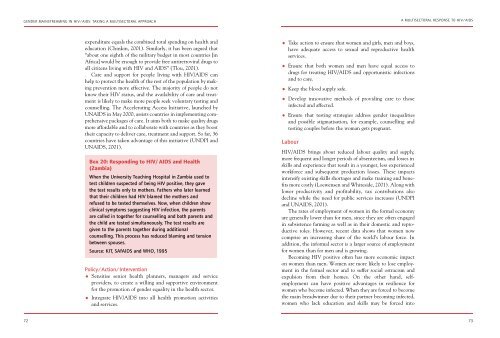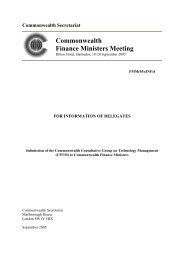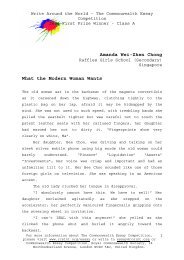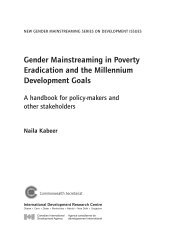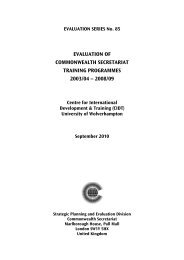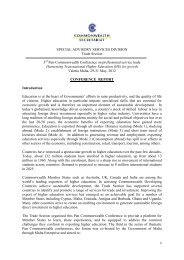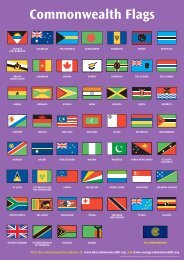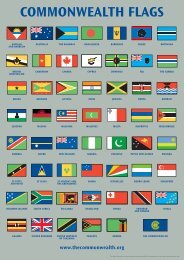Gender Mainstreaming in HIV/AIDS - Commonwealth Secretariat
Gender Mainstreaming in HIV/AIDS - Commonwealth Secretariat
Gender Mainstreaming in HIV/AIDS - Commonwealth Secretariat
You also want an ePaper? Increase the reach of your titles
YUMPU automatically turns print PDFs into web optimized ePapers that Google loves.
GENDER MAINST R E A M I NG IN <strong>HIV</strong>/<strong>AIDS</strong>: TA K I NG A MULT I S E C TORAL APPROACH<br />
expenditure equals the comb<strong>in</strong>ed total spend<strong>in</strong>g on health and<br />
education (Ch<strong>in</strong>k<strong>in</strong>, 2001). Similarly, it has been argued that<br />
“about one eighth of the military budget <strong>in</strong> most countries [<strong>in</strong><br />
Africa] would be enough to provide free antiretroviral drugs to<br />
all citizens liv<strong>in</strong>g with <strong>HIV</strong> and <strong>AIDS</strong>” (Tlou, 2001).<br />
Care and support for people liv<strong>in</strong>g with <strong>HIV</strong>/<strong>AIDS</strong> can<br />
help to protect the health of the rest of the population by mak<strong>in</strong>g<br />
prevention more effective. The majority of people do not<br />
know their <strong>HIV</strong> status, and the availability of care and treatment<br />
is likely to make more people seek voluntary test<strong>in</strong>g and<br />
counsell<strong>in</strong>g. The Accelerat<strong>in</strong>g Access Initiative, launched by<br />
UN<strong>AIDS</strong> <strong>in</strong> May 2000, assists countries <strong>in</strong> implement<strong>in</strong>g comprehensive<br />
packages of care. It aims both to make quality drugs<br />
more affordable and to collaborate with countries as they boost<br />
their capacity to deliver care, treatment and support. So far, 36<br />
countries have taken advantage of this <strong>in</strong>itiative (UNDPI and<br />
UN<strong>AIDS</strong>, 2001).<br />
Box 20: Respond<strong>in</strong>g to <strong>HIV</strong>/<strong>AIDS</strong> and Health<br />
(Zambia)<br />
Source:<br />
Policy/Action/Intervention<br />
• Sensitise senior health planners, managers and service<br />
providers, to create a will<strong>in</strong>g and supportive environment<br />
for the promotion of gender equality <strong>in</strong> the health sector.<br />
• Integrate <strong>HIV</strong>/<strong>AIDS</strong> <strong>in</strong>to all health promotion activities<br />
and services.<br />
• Take action to ensure that women and girls, men and boys,<br />
have adequate access to sexual and reproductive health<br />
services.<br />
• Ensure that both women and men have equal access to<br />
drugs for treat<strong>in</strong>g <strong>HIV</strong>/<strong>AIDS</strong> and opportunistic <strong>in</strong>fections<br />
and to care.<br />
• Keep the blood supply safe.<br />
• Develop <strong>in</strong>novative methods of provid<strong>in</strong>g care to those<br />
<strong>in</strong>fected and affected.<br />
• Ensure that test<strong>in</strong>g strategies address gender <strong>in</strong>equalities<br />
and possible stigmatisation, for example, counsell<strong>in</strong>g and<br />
test<strong>in</strong>g couples before the woman gets pregnant.<br />
<strong>HIV</strong>/<strong>AIDS</strong> br<strong>in</strong>gs about reduced labour quality and supply,<br />
more frequent and longer periods of absenteeism, and losses <strong>in</strong><br />
skills and experience that result <strong>in</strong> a younger, less experienced<br />
workforce and subsequent production losses. These impacts<br />
<strong>in</strong>tensify exist<strong>in</strong>g skills shortages and make tra<strong>in</strong><strong>in</strong>g and benefits<br />
more costly (Loewensen and Whiteside, 2001). Along with<br />
lower productivity and profitability, tax contributions also<br />
decl<strong>in</strong>e while the need for public services <strong>in</strong>creases (UNDPI<br />
and UN<strong>AIDS</strong>, 2001).<br />
The rates of employment of women <strong>in</strong> the formal economy<br />
are generally lower than for men, s<strong>in</strong>ce they are often engaged<br />
<strong>in</strong> subsistence farm<strong>in</strong>g as well as <strong>in</strong> their domestic and reproductive<br />
roles. However, recent data shows that women now<br />
comprise an <strong>in</strong>creas<strong>in</strong>g share of the world’s labour force. In<br />
addition, the <strong>in</strong>formal sector is a larger source of employment<br />
for women than for men and is grow<strong>in</strong>g.<br />
Becom<strong>in</strong>g <strong>HIV</strong> positive often has more economic impact<br />
on women than men. Women are more likely to lose employment<br />
<strong>in</strong> the formal sector and to suffer social ostracism and<br />
expulsion from their homes. On the other hand, selfemployment<br />
can have positive advantages <strong>in</strong> resilience for<br />
women who become <strong>in</strong>fected. When they are forced to become<br />
the ma<strong>in</strong> breadw<strong>in</strong>ner due to their partner becom<strong>in</strong>g <strong>in</strong>fected,<br />
women who lack education and skills may be forced <strong>in</strong>to<br />
A MULT I S E C TORAL RESPONSE TO <strong>HIV</strong>/<strong>AIDS</strong><br />
72 73


